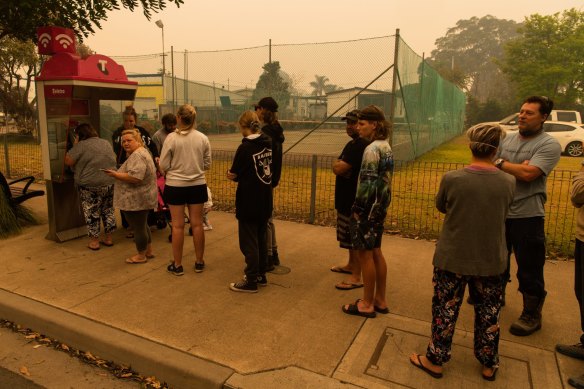She also said COVID-19 was particularly hard on Brunswick West, which was one of a handful of postcodes briefly placed under extra restrictions at the start of the major second wave of 2020.
The phone up for heritage listing in Melbourne’s inner north.Credit: Simon Schluter
“I’m sure it has saved many, many people from really hard times,” Di Sipio said of the phone booth.
Oliver Maclatchy, who owns a timber business just metres from the phone, said Brunswick West was one of the last strongholds of inner-northern Melbourne’s traditionally disadvantaged population as hipsters moved in.
“You’ve got these last few public and affordable homes that are one of the last spots for people who are probably less fortunate,” he said. “This phone is probably pretty important for them.”
Naomi Parry Duncan, who is leading Telstra’s heritage-listing application to the National Trust, was trapped in Narooma during the deadly summer fires of 2019-20.
The power was out, the internet was gone and the mobile phone tower had been knocked out in the flames.

A line for a public phone in Narooma on New Year’s Day in 2020. The actual phone box up for heritage listing is further south in the town.Credit: James Brickwood
“It was really bleak and terrifying,” Parry Duncan said. “After a day, word rippled through the [evacuation] centre that Telstra had made the public phones free, so everybody rushed up.
“They were the only way that we could communicate with the outside world. They were just absolutely crucial. It was the way that we let our families and our friends know that we were OK. We could arrange to evacuate ourselves. And we could also meet up with people outside the phone.
“It was really just an incredible, social, amazing experience. The public phone was just an anchor for the community in that time.”
Nearly 1000 calls were made from the Narooma phone box, on the Princes Highway, in just two months, Telstra says.
The public phone in Narooma up for heritage listing.
Since public phones became free in 2021, it says, more than 25 million calls have been made around the country, including more than 300,000 to Triple Zero and other crisis support lines.
In far north-west Queensland, Telstra recorded about one call for every person in the remote Indigenous town of Doomadgee – population 1387 – from its isolated public phone over the past year.
Free Wi-Fi was installed last year too. But few would be bold enough to venture into the phone booth itself for a prolonged call during summer, when temperatures inside can reach 60 degrees, Telstra says.
Parry Duncan, the president of the Professional Historians Association in NSW and the ACT, said Telstra’s submission to the National Trust would argue the three chosen sites were home to culturally significant pieces of technology and represented the importance of public phones in Australia.
If approved, such a listing would have no legal effect and would not stop any changes being made to the phone boxes.
But Parry Duncan said a successful listing “ripples through” to other council and state government heritage considerations, and could be marked with a small plaque.
“The advantage of drawing attention to these mundane objects with a heritage listing is to make people think about them,” she said. “And think about locations of culture and what these things mean to people, particularly when times are tough.”
Lifeline chief executive Colin Seery said nearly 14,000 calls to the crisis support service came through public phones last year.
Jimmy Numbato, watched by Jacob Miler, uses a new phone at Daly River Crossing in the Northern Territory in 1985.Credit: Ray Kennedy
“It’s a powerful reminder of the important role they continue to play in our communities, and it’s encouraging to see that role being recognised,” he said.
Teresa Corbin, Telstra’s chief customer advocate, said Australia’s relationship with phone boxes was a one-off.
“While some countries and cities have abolished their public phones entirely, Australia has a unique relationship and rich history with them,” she said. “Despite the prevalence of mobile phones, they’re still actively used nationwide and are critical to helping individuals and communities stay connected.”
Lifeline 13 11 14
Start the day with a summary of the day’s most important and interesting stories, analysis and insights. Sign up for our Morning Edition newsletter.
Read the full article here

